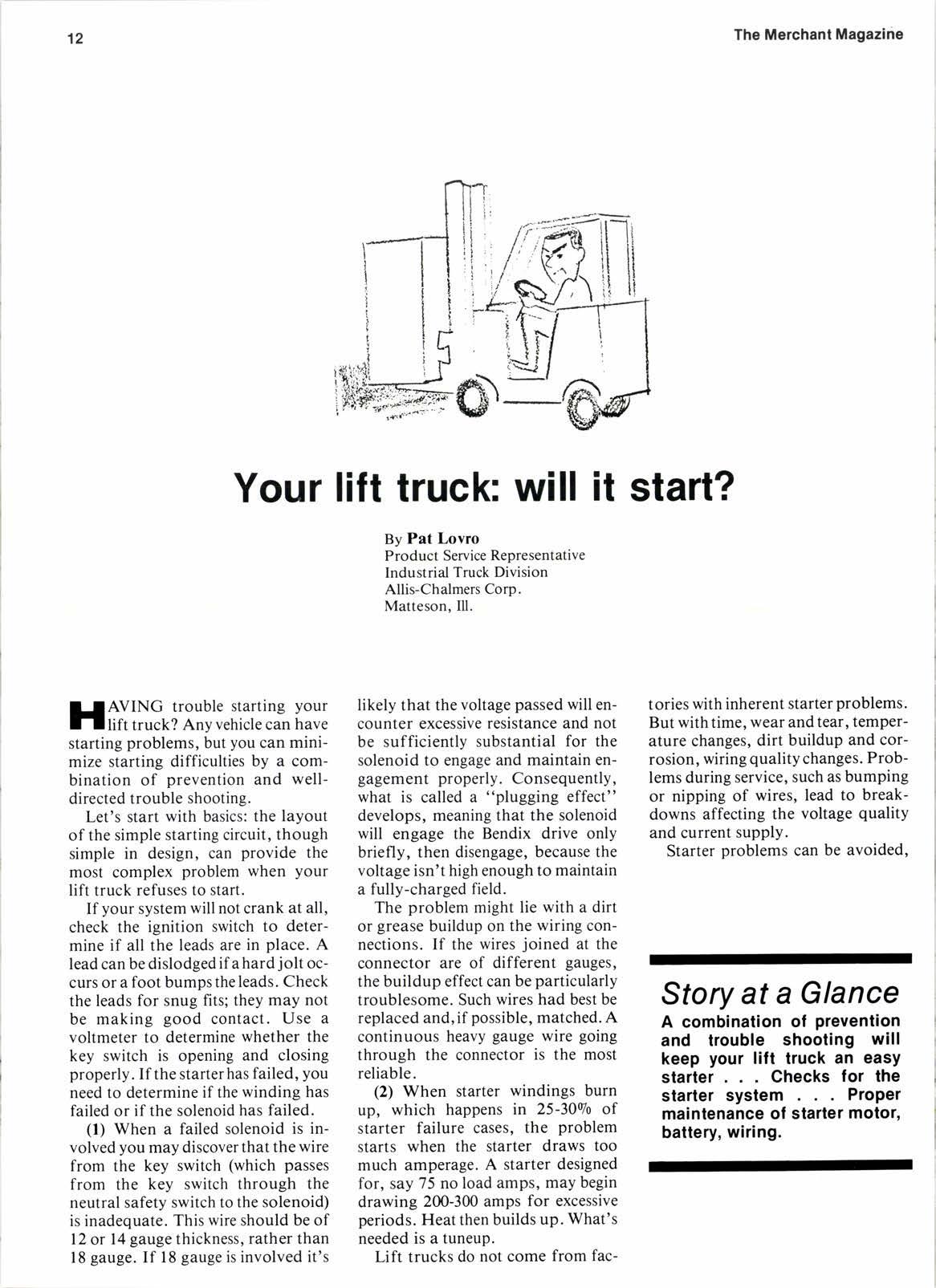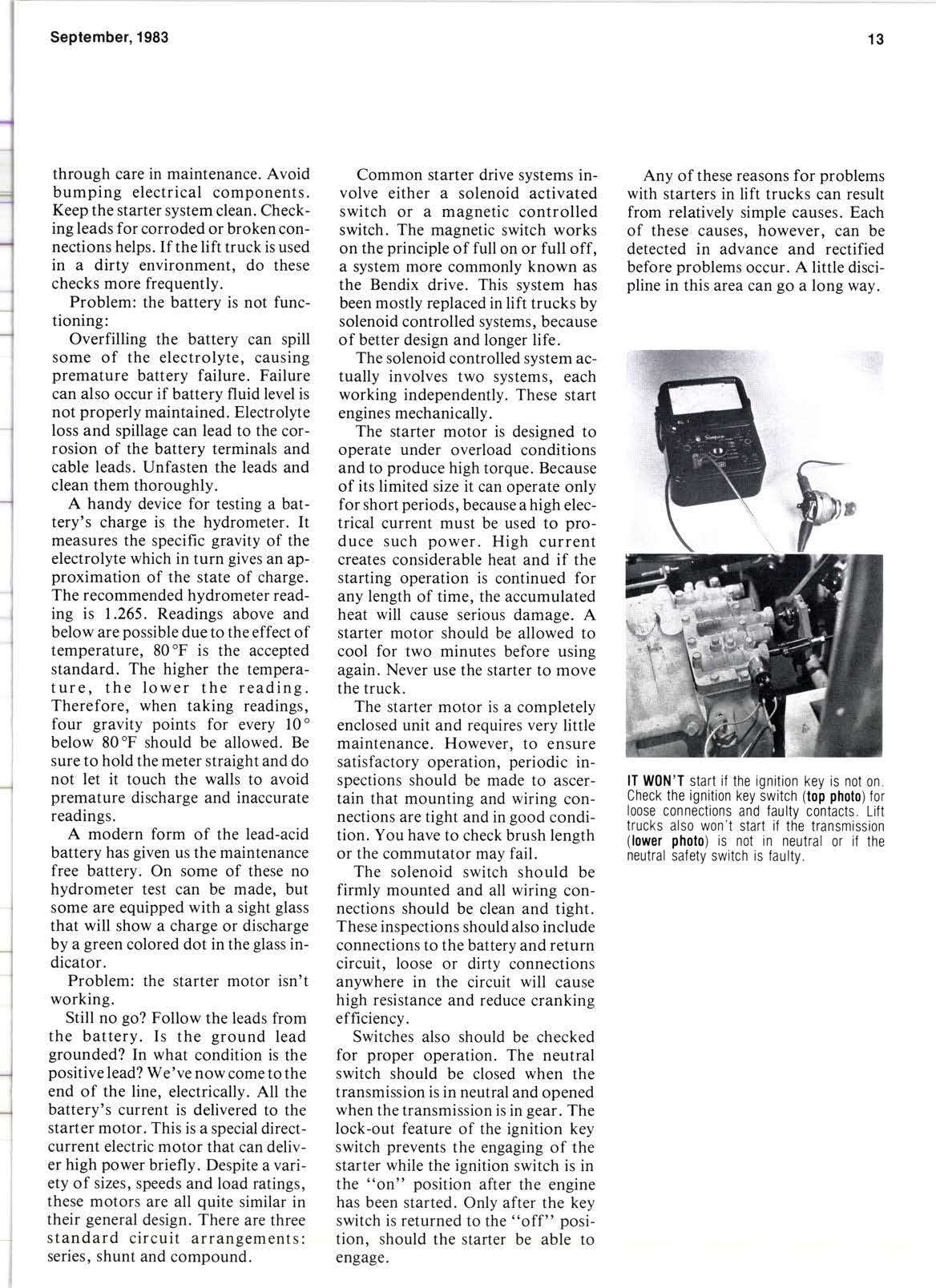
4 minute read
Your lift truck will it start?
By Pat Lovro Product Service Representative Industrial Truck Division Allis-Chalmers Corp. Matteson, Ill.
IJAVING trouble starting your n lift truck? Anv vehicle can have starting problems, 6ut you can minimize starting difficulties by a combination of prevention and welldirected trouble shooting.
Let's start with basics: the layout of the simple starting circuit, though simple in design, can provide the most complex problem when your lift truck refuses to start.
If your system will not crank at all, check the ignition switch to determine if all the leads are in place. A lead can be dislodged if ahard jolt occurs or a foot bumps the leads. Check the leads for snug fits; they may not be making good contact. Use a voltmeter to determine whether the key switch is opening and closing properly. Ifthe starterhas failed, you need to determine if the winding has failed or if the solenoid has failed.
(l) When a failed solenoid is involved you may discover that the wire from the key switch (which passes from the key switch through the neutral safety switch to the solenoid) is inadequate. This wire should be of 12 or 14 gauge thickness, rather than l8 gauge. If l8 gauge is involved it's likely that the voltage passed will encounter excessive resistance and not be sufficiently substantial for the solenoid to engage and maintain engagement properly. Consequently, what is called a "plugging effect" develops, meaning that the solenoid will engage the Bendix drive only briefly, then disengage, because the voltage isn't high enough to maintain a fully-charged field.
The problem might lie with a dirt or grease buildup on the wiring connections. If the wires joined at the connector are of different gauges, the buildup effect can be particularly troublesome. Such wires had best be replaced and, if possible, matched. A continuous heavy gauge wire going through the connector is the most reliable.
(2) When starter windings burn up, which happens in 25-3090 of starter failure cases, the problem starts when the starter draws too much amperage. A starter designed for, say 75 no load amps, may begin drawing 200-300 amps for excessive periods. Heat then builds up. What's needed is a tuneup.
Lift trucks do not come from fac- tories with inherent starter problems. But with time, wear and tear, temperature changes, dirt buildup and corrosion, wiring quality changes. Problems during service, such as bumping or nipping of wires, lead to breakdowns affecting the voltage quality and current supply.
Starter problems can be avoided,
Sfory at a Glance
A combination ol prevention and trouble shooting will keep your lilt truck an easy starter . Checks for the starter system ProPer maintenance of starter motor, battery, wiring.
through care in maintenance. Avoid bumping electrical components. Keep the starter system clean. Checking leads for corroded or broken connections helps. Ifthe lift truck is used in a dirty environment, do these checks more frequently.
Problem: the battery is not functioning:
Overfilling the battery can spill some of the electrolyte, causing premature battery failure. Failure can also occur if battery fluid level is not properly maintained. Electrolyte loss and spillage can lead to the corrosion of the battery terminals and cable leads. Unfasten the leads and clean them thoroughly.
A handy device for testing a battery's charge is the hydrometer. It measures the specific gravity of the electrolyte which in turn gives an approximation of the state of charge. The recommended hydrometer reading is 1.265. Readings above and below are possible due to the effect of temperature, 80 oF is the accepted standard. The higher the temperature, the lower the reading. Therefore, when taking readings, four gravity points for every l0o below 80'F should be allowed. Be sure to hold the meter straight and do not let it touch the walls to avoid premature discharge and inaccurate readings.
A modern form of the lead-acid battery has given us the maintenance free battery. On some of these no hydrometer test can be made, but some are equipped with a sight glass that will show a charge or discharge by a green colored dot in the glass indicator.
Problem: the starter motor isn't working.
Still no go? Follow the leads from the battery. Is the ground lead grounded? In what condition is the positive lead? We've now come to the end of the line, electrically. All the battery's current is delivered to the starter motor. This is a special directcurrent electric motor that can deliver high power briefly. Despite a variety of sizes, speeds and load ratings, these motors are all quite similar in their general design. There are three standard circuit arrangements: series, shunt and compound.
Common starter drive systems involve either a solenoid activated switch or a magnetic controlled switch. The magnetic switch works on the principle of full on or full off, a system more commonly known as the Bendix drive. This system has been mostly replaced in lift trucks by solenoid controlled systems, because of better design and longer life.

The solenoid controlled system actually involves two systems, each working independently. These start engines mechanically.
The starter motor is designed to operate under overload conditions and to produce high torque. Because of its limited size it can operate only for short periods, because a high electrical current must be used to produce such power. High current creates considerable heat and if the starting operation is continued for any length of time, the accumulated heat will cause serious damage. A starter motor should be allowed to cool for two minutes before using again. Never use the starter to move the truck.
The starter motor is a completely enclosed unit and requires very little maintenance. However, to ensure satisfactory operation, periodic inspections should be made to ascertain that mounting and wiring connections are tight and in good condition. You have to check brush length or the commutator may fail.
The solenoid switch should be firmly mounted and all wiring connections should be clean and tight. These inspections should also include connections to the battery and return circuit, loose or dirty connections anywhere in the circuit will cause high resistance and reduce cranking efficiency.
Switches also should be checked for proper operation. The neutral switch should be closed when the transmission is in neutral and opened when the transmission is in gear. The lock-out feature of the ignition key switch prevents the engaging of the starter while the ignition switch is in the "on" position after the engine has been started. Only after the key switch is returned to the "off" position, should the starter be able to engage.
Any of these reasons for problems with starters in lift trucks can result from relatively simple causes. Each of these causes, however, can be detected in advance and rectified before problems occur. A little discipline in this area can go a long way.










